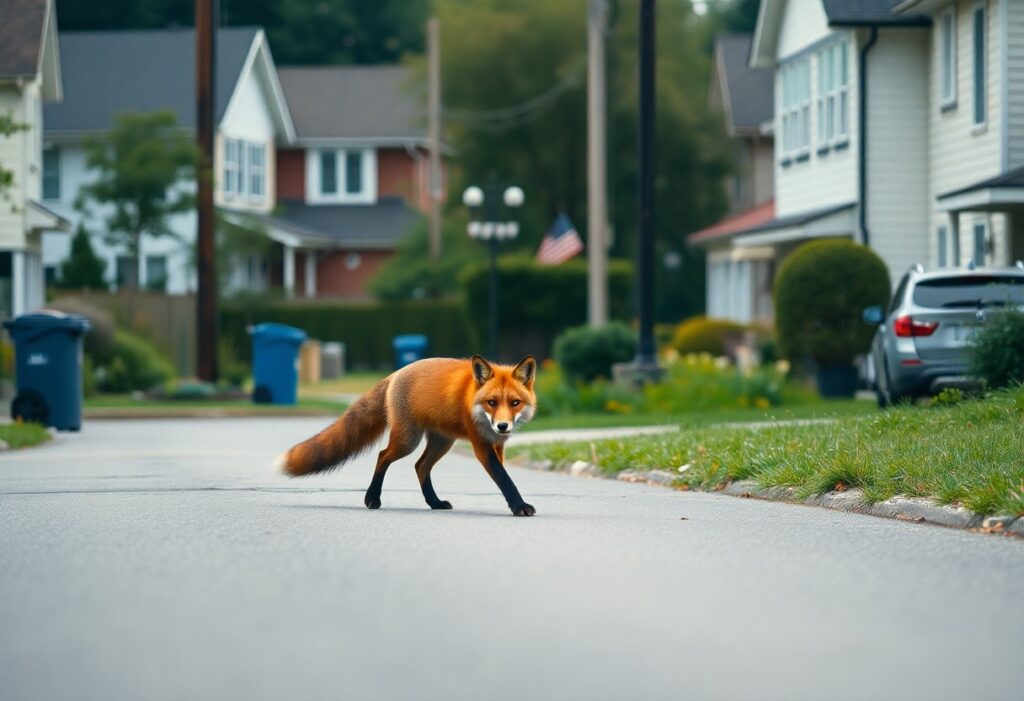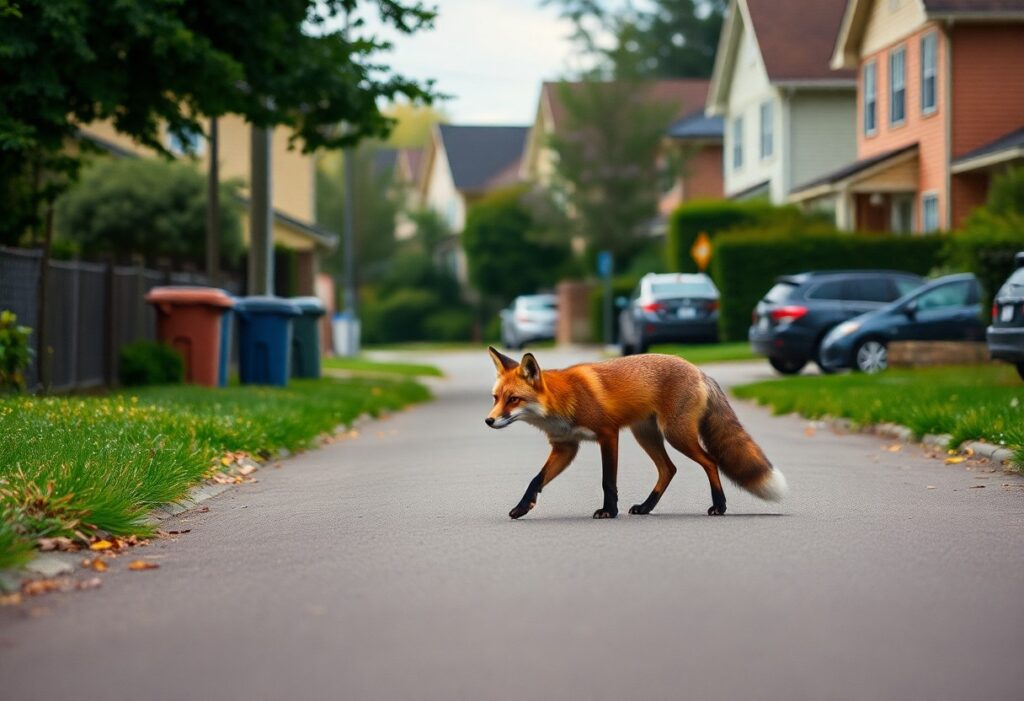Foxes have successfully adapted to urban environments, often becoming a common sight in cities and suburbs. You might be curious about their behavior, diet, and how they interact with human populations.
In this comprehensive guide, you’ll learn everything you need to know about urban foxes, including how to coexist with them, the challenges they face, and what their presence means for your local ecosystem.
Get ready to explore the fascinating world of these adaptable creatures and enhance your understanding of your urban wildlife neighbors.
Key Takeaways:
- Urban foxes have adapted remarkably to city life, utilizing parks, gardens, and other green spaces for foraging and denning.
- They play an necessary role in urban ecosystems by controlling rodent populations and scavenging waste, contributing to urban biodiversity.
- Understanding their behavior and habits can help reduce human-wildlife conflict, allowing for coexistence in suburban and urban areas.
The Urban Fox: An Overview
A fascinating example of wildlife adapting to modern environments, the urban fox has become a common sight in urban and suburban areas.
These clever creatures thrive in urban settings, where they scavenge for food and create dens in gardens and parks.

Characteristics of Urban Foxes
Urban foxes are typically smaller than their rural counterparts, with distinct reddish fur, long bushy tails, and pointed ears.
Their adaptability allows them to blend seamlessly into city life, making them an intriguing part of the urban landscape.
You may notice their behavior varies, as they become more comfortable around humans and exhibit clever scavenging techniques.
The Adaptation to City Life
Adaptation is key to the survival of urban foxes, who have developed various strategies to thrive in bustling environments. They often forage for food in bins and alleys, taking advantage of easily accessible meals.
Characteristics of urban foxes include heightened agility and intelligence, which play a significant role in their ability to navigate city obstacles.
You will find that urban foxes are more nocturnal; they tend to be more active at night to avoid human interaction while searching for food and safe places to rest.
This adaptability not only ensures their survival but also showcases their remarkable resilience in the face of change.
Habitat and Distribution of Urban Foxes
There’s no denying that urban foxes have adapted remarkably well to city life. They thrive in various environments, finding homes in parks, gardens, and even neighborhoods.
Cities provide ample food sources, shelter options, and minimal natural predators, allowing foxes to flourish in suburban areas and metropolitan regions alike.
Ideal Urban Environments
Environments that suit urban foxes typically include green spaces interspersed with residential areas. Parks, wooded areas, and overgrown gardens offer crucial cover and nesting sites.
Moreover, foxes often take advantage of human waste, scavenging through refuse for food, which makes urban settings particularly appealing.
Where to Find Foxes in Suburbs
Among the places you might spot foxes in suburban areas are quiet streets, backyard gardens, and local parks. They often come out during twilight or nighttime hours when it’s quieter, allowing them to forage without encountering too many humans.
Ideal locations for finding foxes in the suburbs include areas with plenty of vegetation, such as hedgerows and wooded patches.
Look for them near parks, green belts, or even near waterways, as these spots provide rich hunting grounds for their preferred prey, small mammals and birds. Hearing their distinctive calls or spotting them foraging can enhance your suburban wildlife experience.
Diet and Behavior
Now that you understand the presence of urban foxes in your neighborhood, it’s necessary to research into their diet and behavior.
These adaptable creatures have evolved to thrive amidst city life, showcasing remarkable dietary flexibility and socially complex interactions within their communities.
What Urban Foxes Eat
For urban foxes, the diet is diverse and opportunistic, encompassing everything from small mammals, birds, and insects to human leftovers like trash and pet food.
You might even spot them scavenging near your local parks or neighborhoods, showcasing their ability to thrive in an urban setting.
Social Structure and Territoriality
Behind the adaptable diet is a rich social structure, where urban foxes establish territories to ensure their survival. You may notice that these foxes are generally solitary but can also form small family groups, especially during breeding season.
Indeed, the social dynamics among urban foxes revolve around territorial boundaries and vocal communications, such as barks and screeches. Each fox typically occupies its territory, which it marks with scent to ward off intruders.
Understanding these behaviors allows you to appreciate their role in the urban ecosystem, as they help control pest populations while navigating the complexities of city living.
Knowing how they interact can also enhance your experience when observing them in your area, providing insights into their fascinating lives amidst human activity.
Interaction with Humans
Keep in mind that urban foxes often adapt to human presence, leading to fascinating interactions. While they may seem curious or unafraid, it’s necessary to respect their wild nature.
Foxes view humans as a potential source of food, which can encourage bold behavior. It’s important to ensure that you do not feed them or leave food scraps in your yard, as this can lead to increased interactions and dependency on human resources.
Common Myths and Misconceptions
About urban foxes, many people believe they are dangerous or overly aggressive towards humans. In reality, foxes typically avoid human contact and only become a nuisance when food sources are easily accessible.
Understanding their behavior helps dispel these myths and promotes a more harmonious coexistence.
Coexistence Strategies
Strategies to peacefully coexist with urban foxes include securing your trash, avoiding feeding them, and removing potential den sites from your property.
This type of proactive management can minimize potential conflicts and help maintain a healthy ecosystem.
Another effective strategy is to educate your community about fox behavior and the importance of preserving their natural habitats.
By fostering an environment where both urban foxes and residents can thrive, you create a balanced coexistence that benefits everyone involved.
Encourage your neighbors to adopt similar practices so that the presence of foxes can be appreciated rather than feared, making your area more wildlife-friendly.
Health and Safety Concerns
All urban foxes can pose health and safety concerns for you and your community. While they generally avoid human interaction, their presence can raise questions regarding their impact on local wildlife and public health.
Diseases Carried by Foxes
Along with their fascinating behavior, urban foxes can carry diseases that may affect pets and, in rare instances, humans.
Conditions such as mange, ticks, and parasites could be transmitted, so it’s wise to keep your pets vaccinated and monitored.
Human Safety and Foxes
Besides health concerns, you may worry about the safety of encounters between foxes and humans.
Urban foxes are typically shy and will avoid direct contact. However, if they feel threatened, they may react defensively, especially if they are protecting their young.
At night, when foxes are most active, maintaining a respectful distance is advisable. Avoid approaching them, and keep food sources secured to discourage them from frequenting your area.
Observing them safely from afar can allow you to appreciate these urban survivors without putting yourself at risk.

Conservation and the Future of Urban Foxes
For the sustainability of urban wildlife, it’s vital to address the conservation needs of urban foxes. As human populations continue to grow in cities, the landscape surrounding foxes rapidly evolves.
Effective conservation strategies will ensure these adaptable creatures can thrive while coexisting with human communities, preserving their role in urban ecosystems.
Impact of Urbanization
Among the many challenges urbanization brings, habitat fragmentation poses a significant threat to fox populations.
As cities expand, natural spaces are reduced, which can lead to a decline in food sources and breeding habitats for foxes.
This urban pressure forces them to adapt more to human environments, affecting their behavior and health.
Efforts to Protect Urban Fox Populations
Future initiatives aimed at protecting urban fox populations focus on habitat preservation and community education. Through responsible urban planning and public outreach, you can play a role in creating spaces that support wildlife while fostering coexistence with human residents.
With increasing awareness about the importance of urban biodiversity, many local governments and conservation groups are implementing programs to protect urban foxes.
These efforts may include creating green corridors, providing educational resources to residents about fox behavior, and establishing guidelines for managing human-fox interactions.
By advocating for balanced urban planning that considers wildlife, you contribute to creating an environment where foxes can thrive alongside you in your community.
Final Words
Conclusively, understanding urban foxes equips you with the knowledge necessary to coexist harmoniously with these fascinating creatures in your city or suburb.
By being informed about their behaviors, diets, and the potential challenges they pose, you can better appreciate their role in urban ecosystems. Embracing this connection can enhance your experience living in proximity to wildlife, as well as guide your actions to ensure a balanced relationship with these adaptable animals.
Your insight into their lives will not only foster respect but also enrich your awareness of the diverse community that surrounds you.
FAQ
What are urban foxes and how do they adapt to city life?
- Urban foxes, typically the red fox (Vulpes vulpes), have adapted to city and suburban environments by altering their behaviors and diet. They thrive in areas with readily available food sources, such as discarded food, pet food, and small animals. Urban foxes often become nocturnal to avoid human activity and can navigate through parks, gardens, and backyards with ease. Their ability to blend into urban settings has allowed them to maintain stable populations despite human encroachment.
What do urban foxes eat?
- The diet of urban foxes is quite diverse, consisting of small mammals like rodents, birds, and rabbits, as well as fruits and insects. In cities, they are opportunistic feeders and may scavenge from garbage bins or take advantage of pet food left outside. This varied diet helps them adapt to different environments and makes them resilient in urban landscapes.
Are urban foxes dangerous to pets and humans?
- Generally, urban foxes pose minimal danger to pets and humans. They are typically shy and will avoid confrontation. However, there are rare instances where foxes may take small pets, especially young or vulnerable ones. To keep pets safe, it’s advisable to supervise them outdoors and avoid leaving food outside that could attract foxes. Human encounters are usually non-threatening, as foxes prefer to keep their distance.
How can I coexist with urban foxes in my neighborhood?
- Coexisting with urban foxes involves making your environment less appealing to them while understanding their role in the local ecosystem. Securing garbage bins, cleaning up fallen fruits from gardens, and avoiding the feeding of foxes can help deter them from your property. If you do spot a fox, it’s best to leave it alone and appreciate its presence as a part of urban wildlife.
What should I do if I see a sick or injured urban fox?
- If you encounter a sick or injured urban fox, it is important to keep a safe distance and avoid approaching it, as injured animals may act unpredictably. Contact a local wildlife rehabilitation center or animal control for guidance on the best course of action. They can assess the situation and take appropriate measures to assist the animal if necessary.


